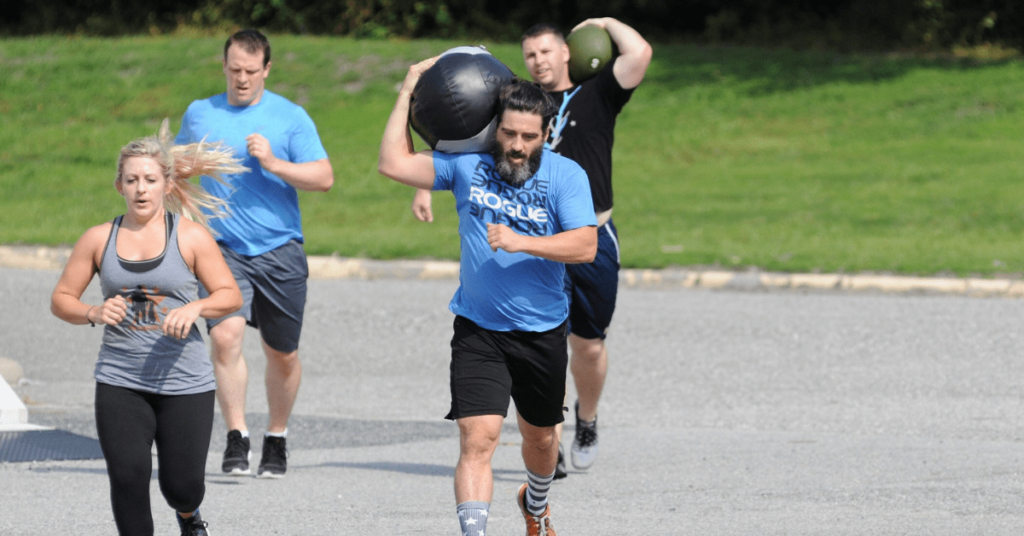Boot-camp style workouts have been around for decades but now they are more popular than ever. Outdoor bootcamps combine a series of bodyweight exercises and high-intensity movements like push-ups and burpees loosely based around military methods used for whipping new recruits into shape.
The American College of Sports Medicine listed group training as the second biggest trend for 2019. The group fitness class is a tough market to break into if you don’t have the right tools at the beginning. However, there’s an opportunity to create a thriving fitness business with an outdoor bootcamp. In this article, we will discuss the steps you need to take to kickstart your business.
Why Bootcamp Workouts are So Effective
Bootcamp workouts emphasize total body functional training and strength training. A typical outdoor fitness camp usually features a small group of people in an open outdoor public space like a park. The types of exercise aim to burn calories fast and improve fitness and strength.
With the rise of group activity and training, exercising with a group can take your workout to the next level. One study found that 95% of those who started a weight-loss program with friends completed the program. The friend group was also 43% more likely to keep the weight off. Outdoor bootcamps are usually run by qualified and knowledgable fitness instructors.
4 Fantastic Outdoor Bootcamp Classes

Source: trainingcamp-nyc.com
Working out in the sunshine and fresh air can feel amazing which is why these outdoor bootcamp classes are in demand. They challenge you and force you to power you through drills in a group training setting. Here are four that get it right.
Minardi Beach Workout, New York
Located in East Hampton, the 75-minute sessions are taught by personal trainer and yogi Jimmy Minardi. On the beach, class goers can expect to do push-ups on driftwood, splash through water and race around cones on the sand. All you need to do is bring your own towel and get ready to sweat.
Bulldog Bootcamp, Chicago
Following a more military-style bootcamp, the instructor also known as Sergeant Friday delivers a serious workout. Classes meet in the mornings in Lincoln Park on the grass for body-weight exercise and running drills.
Outdoor Training C.A.M.P. XT, New York
Led by former pro football Curtis Williams, classes whip athletes into shape through a mixture of resistance training, drills, and burpees in Central Park. Classes are finished off with a motivating team huddle.
Beach Cross Bootcamp, Miami
Another beachfront bootcamp class, Beach Cross was created by fitness power duo Tracie and Christopher Vlaun. You can expect high-intensity cardio, strength and core training all followed by a yoga cool-down stretch. Towels and water are provided at the class.
9 Key Steps to Starting an Awesome Outdoor Bootcamp Business
Today’s marketing environment offers a lot of opportunities for personal trainers and business owners to reach more people than ever before. You just have to know what you need to succeed and how to apply it to your own business. Here are nine key elements you will need in order to create and launch a successful outdoor bootcamp business.
1. Find Your Focus
New fitness bootcamps pop up every year and if you want to stay in business and stand out from the rest, you need to find your focus. If you’re going to enter into a niche like getting brides into shape before their wedding or precisely following a military-style workout, make sure it attracts the right audience. Finding your focus means writing out a detailed plan of how you will launch your business, the procedures, and systems you’ll have in place to manage it and finally, how you will keep your clients coming back for more week on week.
For fitness entrepreneurs looking to develop and grow their business, check out these brilliant reads:
- Two-Brain Business: Grow Your Gym by Chris Cooper – written by the CrossFit Catalyst founder and owner, this book is a must-read guide for any fitness business owner. Cooper focuses on strategies for owning and running a thriving small business.
- The E-Myth Revisited: Why Most Small Businesses Don’t Work and What to Do About It by Michael E. Gerber – this book is great for avoiding common mistakes that small businesses make.
- Built to Last: Successful Habits of Visionary Companies by By James Collins and Jerry Porras – this one is all about building strategies for long-term success. Read numerous case studies from big names like General Electric, Colgate and Hewlett-Packard.
2. Choose Your Location
Your location will be one of the most important decisions you make when starting your bootcamp business. Using parks as a free space is a very appealing part of a bootcamp business but it doesn’t mean it comes without any costs. Many cities throughout the U.S. require permits and charging fees for hosting group workouts in public places. Although this cost is considerably less than renting a gym or studio space, it’s still a price that needs to be factored into your business plan.
Make sure to carry out thorough research once you’ve narrowed down your potential location. Double-check what permits and costs need to be arranged before you start organizing your first bootcamp. Other factors to think about when deciding on a location is how central it is, how easy is it to get to and is your potential clientele nearby. The likelihood is that your clients will work or live within a few miles. By carrying out in-depth research on your potential clients, you can choose a location that’s perfect for your business.
3. Equipment
When you’re just starting out, don’t spend a ton on brand new equipment. Use your skills from being a personal trainer or fitness instructor and make use of your environment. A great workout can just be a simple combination of cardio, bodyweight and partner exercises. As well as the cost of new equipment you also need to think about the issues that arise with trying to get heavy equipment to your bootcamp location.
The Customer
Engagement Playbook
for Your Fitness
Business
Discover more When you’re looking for mobile bootcamp equipment to set your workouts on fire, be resourceful and consider purchasing:
- Cones
- Resistance bands
- Tires
- Agility ladders
- Kettlebells
- Medicine balls
- Jump rope
4. Pricing
Landing on a price system that works for you and your business can be tricky. Set a fair price for your services and stick with it. Whether you offer one free session, a pay as you go system or a 10-week program to whip clients into shape is entirely down to you. While pay as you go is a great option to attract new recruits, ideally you want to get cash flow upfront. This is where running an 8 or 10-week program comes in.
When a client signs up to ten weeks, it not only helps get cash flow into the business quickly, it also helps with their commitment and motivation to show up every week. As well as weekly programs, monthly memberships are an ideal way to grow your business. By offering bootcamp programs, it gives clients the time to get hooked on your brand and fitness. If you plan to use more than one location, this widens your net of potential clients. You can then offer multiple location memberships as well as single location memberships to make the most out of your audience.
5. Schedule
When people start to hear about you and visit your website, the first thing they’ll look at is your locations and next will be what they see on your schedule. Set your class time, whether that’s 45 minutes or an hour – make it something that works for you. It’s always better to start with a bigger schedule as you can scale back and manage the classes that don’t fill up as well.
Depending on where you’re based, every city is different. Your 6 AM class might be the most popular in one city but almost empty in another. This is why it’s important to have a varied schedule, especially when first starting out. You’ll quickly learn what the most popular time is for your clients, what they want to see more of and remove classes that aren’t doing as well.
When designing your schedule, think about how workouts will vary. Your clients don’t want to feel like they are doing the same exercises for all sessions if they’re going at different times. Offer a good mixture of workouts and consider a unique weekend location that all your members can easily access.
6. Admin Tasks
If you’re starting a new business, there’s no escaping the administrative work that comes with it. You need to be able to keep track of clients and memberships and manage check-ins and payments. Set up a system to help you manage every aspect of your business. If your clients can easily pay for your classes, book through your website or find out the class schedule, your business will come across professional from the beginning.
With the right system, you can keep track of important documents and manage your clients all from one place. The idea is to make the process as simple as possible while providing your clients with the best customer experience.
7. Insurance
Make sure you have any insurance or liability waivers in place. An element to this step is also getting approval from the city so you have permission to run a group fitness class in a public space. A general insurance policy should cover everything you need to. Carry out proper research at this stage and find a policy that matches your needs. What if someone were to hurt themselves during your class? With exercise, there’s always a chance that someone could slip and fall. Having a good insurance policy in place will help protect you from such an event.
8. Marketing
Your marketing efforts will form a major part of how successful your business will be. Once you’ve done the research, got your location locked down and designed your schedule, how will potential clients hear about your new business? If it’s relevant to your neighborhood, start off locally handing out flyers to nearby business and locations, offering up a free class to anyone with a flyer.
Word-of-mouth marketing is a great tool to use but it needs to be used in combination with other marketing methods. Create an online presence with an informative website, social media channels and even a branded app that your clients can book through. It doesn’t matter if you’re starting an outdoor bootcamp or opening a fitness center, our marketing guide for the modern fitness founder gives you the information you need to start.
Here are some great resources for marketing and starting your own business from thought-leaders and experts:
- Purple Cow: Transform Your Business by Being Remarkable by Seth Godin – the Bible of digital marketing, Godin shows how remarkable marketing makes a brand stand out from the crowd. He will tell you how to use marketing techniques that will make you the purple cow in your niche.
- Youtility: Why Smart Marketing Is about Help Not Hype by Jay Baer – this book is all about being different and using marketing in a smart way to improve your target audience’s lifestyle.
9. Celebrate Your Clients’ Success
With the majority of bootcamp style fitness program’s, clients work through a progressive course week in and week out to achieve their fitness goals. Celebrate your client’s incredible achievements regularly. Why not give out certificates or celebratory t-shirts to keep members rewarded and inspired.
Bring your passion with you and your clients will be able to feel it. Ultimately, the success of your bootcamp is down to you. Once people have joined your class, they expect an experience. The greater the experience, the more numbers you’ll be attracting.
In Summary
Now that you have the tools and steps you need to take, you can start to build a successful outdoor bootcamp business. Whether you want to launch your own bootcamp or bring in extra income to your fitness business, bootcamps are a great way to bring in revenue, meet people and build a community.
Table of contents















